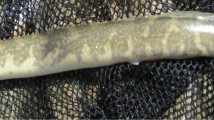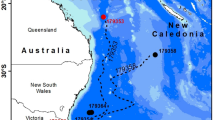Abstract
FROST1 published the first account of the biology of freshwater eels in Kenya. She showed that, of the three species of eel found in the easterly flowing rivers, Anguilla nebulosa labiata Peters is the most abundant above 3,000 ft.; A. mossambica Peters is comparatively rare, and A. bicolor bicolor McClelland is both uncommon and apparently restricted to the lower reaches of rivers. Our own (unpublished) records from the lower Sabaki (Athi) River and from upper tributaries of the Tana River confirm this distribution.
This is a preview of subscription content, access via your institution
Access options
Subscribe to this journal
Receive 51 print issues and online access
$199.00 per year
only $3.90 per issue
Buy this article
- Purchase on SpringerLink
- Instant access to full article PDF
Prices may be subject to local taxes which are calculated during checkout
Similar content being viewed by others
References
Frost, W. E., Colonial Office Fish. Pub., No. 6 (1955).
Harrison, A. C., Piscator, 9, 19 (1955).
Skead, C. J., Piscator, 10, 28 (1956).
Jubb, R. A., Nature, 180, 47 (1957).
Frost, W. E., Nature, 179, 594 (1957).
Barnard, K. H., Piscator, 7, 8 (1953).
Author information
Authors and Affiliations
Rights and permissions
About this article
Cite this article
VAN SOMEREN, V., WHITEHEAD, P. Records of Young Eels in Kenya Rivers. Nature 183, 950 (1959). https://doi.org/10.1038/183950a0
Issue date:
DOI: https://doi.org/10.1038/183950a0
This article is cited by
-
The Inland Fishery Research Station, Sagana, Kenya
Nature (1960)



